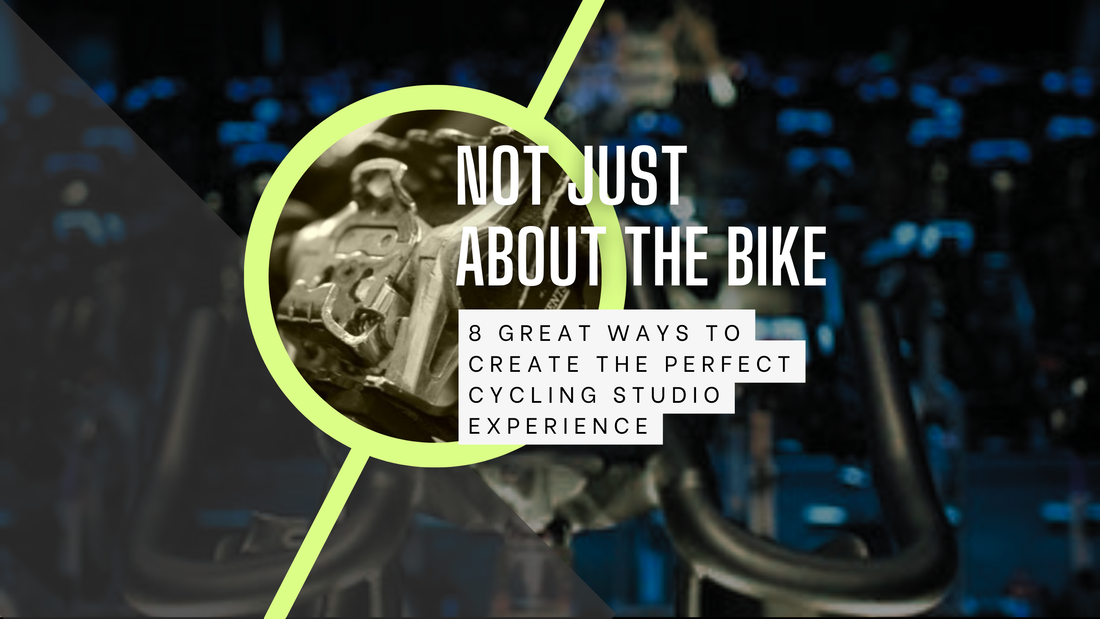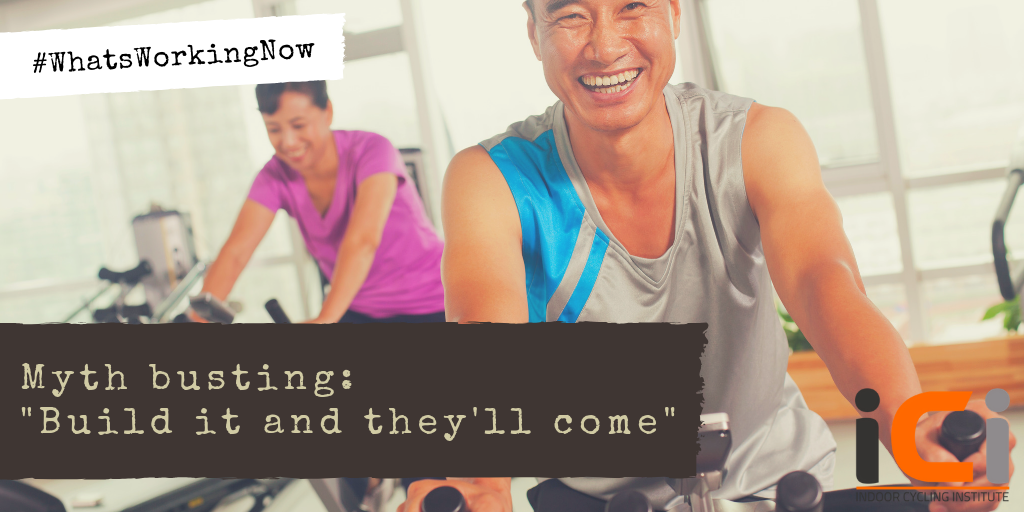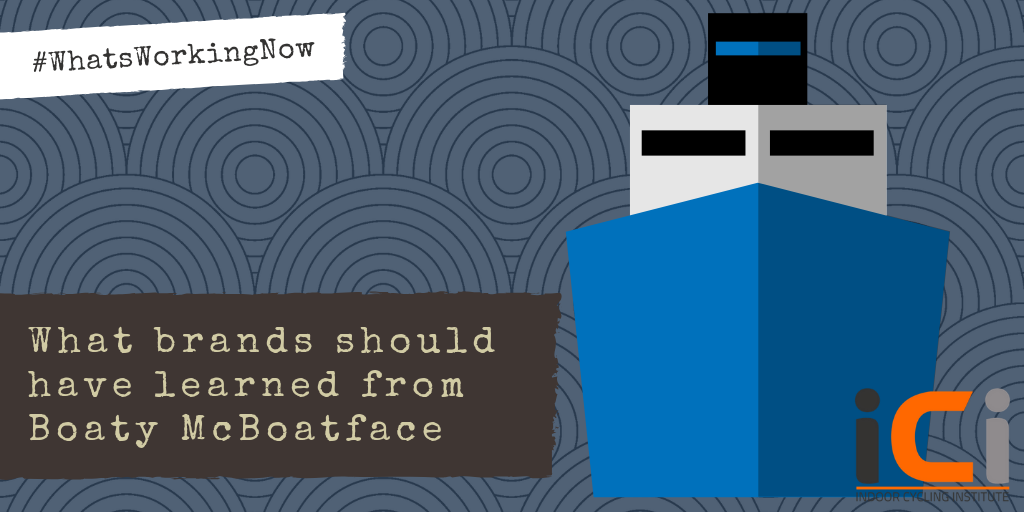- Staff writer It's not necessarily all about the bike. Here are essential elements that every cycling studio should consider to create a memorable member experience.
0 Comments
by Angela Reed-Fox How do you price your indoor cycling classes?How do you determine what's a fair price for an indoor cycling session? Are you happy with what you're charging?
Pricing is important - get it wrong and you'll either be undervaluing your product or pricing yourself out of the market. Just like with resistance and cadence is in balance on a bike, the level of demand should be balanced by the price you're asking riders to pay. There's a sweet spot for both. I took a call today from an ICI instructor. He wanted to know: What's a good price to charge? - he's starting to instruct at a different studio; the bikes are quite basic, there are only a handful of riders who can ride at a time, the gym is new, and they offer gym only membership. What would you do? You need to focus on what you're actually offering - OK the bikes weren't necessarily top of the range, but if the instructor is good (as ICI instructors are!) then they can help any rider get great results with any bike. Studios will often over-invest in bikes thinking that if they've got the latest tech the classes will be brilliant. But if the instructors don't know what they're doing, that investment's wasted. The fact that the instructor I spoke to today is well-equipped, knowledgeable and passionate about giving riders the results they want, and that there aren't lots of bikes available in the class means riders are going to be getting a really top-drawer experience. This experience (and the gym's bottom line) could be improved by a small investment in heartrate training - perhaps with the MyZone system which provides extra motivation, retention - and a secondary income stream. Considering that the gym is seeking to increase interest in the gym by starting to offer indoor cycling sessions but not offer the classes necessarily within the membership, this creates an excellent opportunity. The ICI instructor is contracted by the gym and is incentivised to attract more riders by having a profit share from the classes. In this instance, it makes sense to have a core price that other offers can be compared with. For example, charging £10 per ride for a non-member, and giving members a discount on this yields two things:
Another thing you can think about is selling bundles of rides. Perhaps your newish rider wants to dip their toe in a bit more, but doesn't want to commit to the terms of a membership. In this case you could offer bundles that don't give the saving of a membership, but offer a small discount from a single ride price. Be aware though that anything that's between the 'benchmark' single ride price and what you want riders to go for (loyalty with a membership!) might deter riders from making that decision. You can also offer several-week programmes - perhaps a 'Little Black Dress' programme or a 'Winter Training Programme' - this would have riders signing up and committing to a particular session for a number of weeks. They pay upfront in one, and pay the same whether they turn up to all classes or not. If the gym decides to go down the MyZone heartrate training route, there'll be plenty of crossover as members can use it in the fitness suite as well as all of their classes, this will mean more riders to the cycling studio, as well as more riders exploring other parts of the gym - this approach generally works well for improving member experience, building membership base, as well as that always important bottom line. by Angela Reed Fox Indoor Cycling Studio Manager question: Should you go secondhand for studio bikes?Setting up an indoor cycling studio? One way to get the party started is not to invest in the newest kit, but to go secondhand if there's a local opportunity.
You'll need to weight up the opportunity on its own merit - you need to be thinking about more than just the price. There are two main things to consider:
Are the bikes in reasonable condition? You really need to have a good look, and definitely do checks on all the ones you’re considering buying. The things you need to consider especially considering the price, are:
So that’s all stuff to work out if they’re reasonably priced. But you also need to consider how to future proof the investment you’ll be making in indoor cycling for your venue. Future-proofing your venue
It might be that you’re thinking of just getting some bikes in just to get started, and with a view to upgrading them in the next year or so – that could be an idea. It might be that you're considering secondhand bikes as a first step, to build your studio, and then to invest in better bikes further down the line. There’s usually a way round most things that are not ideal, we’ve found, and we’re happy to help you find the best approach for you. And also we’ve found that gimmicks definitely aren’t the way forward (there’s a reason why cycling studios don’t have bubble machines! We didn’t know this before we bought one when we first opened!) If you'd like us to help or offer advice, get in touch. We are keen to improve the quality of indoor cycling everywhere. It's a tremendously effective activity that can benefit a great variety of people when done properly - and we want to help you make it a success where you are. Of course the best investment you can make in your studio is ensuring your instructors are trained to a high enough standard that they are able to deliver safe, effective and effiicient classes that will boost rider motivation, results, and stickability. A good instructor will make the best of the bikes on offer - a poor instructor will struggle to create an effective class with even the best bikes on the market. We partner with venues to constantly improve their offering - and we endorse those who meet our standards and who are providing reliably good service to their riders. Ask us for more information. by Angela Reed Fox 5 reasons gyms should develop their own indoor cycling instructorsIf you don't have a training strategy for your indoor cycling instructors, stick it on your to-do list - you're missing a massive trick. Opening the region's first boutique cycling studio, we were immediately faced with the issue: Where are we going to get our instructors from? And for the next year or so, we recruited any instructor we thought was suitable who had already done some form of indoor cycling training. We have between 12-15 instructors at any time, there's very low turnover, and the instructors pull together as an excellent team - it wasn't always like that, but here are the reasons why having an indoor cycling training strategy helped: Developing and upholding your brand This is huge. Just because someone looks OK on paper doesn't mean they're a team player. It doesn't mean they're going to care about your members as much as you do, and it doesn't mean they're going to take instructing for you seriously. You need to be able to trust your instructors to uphold your brand when you're not there. Because you can't always be there. If you have a strategy for recognising which of your regular riders would make great instructors and empower them to go do the training, you're going to have instructors who are already signed up to uphold your brand. Why? Because they already think it's great - because they're paying you for it. Added to that, it's a huge boost for them when someone recognises the greatness within! If you're thinking "Ah, but I'll lose members if I turn them into instructors!" Well, yes, you would move that person from the member column to the instructor column - but instructors who understand and love what you're doing and want to be part of it are valuable to you - and worth more than you'll lose in membership fees. In our public-facing studio, we do not recruit instructors from elsewhere - we always develop instructors from our member-base. It works. It cuts the risk of cliques, instructors undermining each other and bad habits brought in from elsewhere. Our instructors are good, we invest in them, and they help maintain the open, friendly and inclusive studio set-up. In return, we help to make them the best they can be. Quality control There are certain things that we didn't want our instructors doing in class - things that are still taught in some training courses. We'd had occasions where the response was "Well they like it at xxxxx". It's important to have your studio policy updated with banned moves as some dangerous and/or ineffective moves are still doing the rounds, despite the increased risk of injury and litigation. If you're developing your riders, you can set the training pathway. Obviously it's easy for us; our instructors-to-be go on our own course - because it's the only instructor course that reaches the quality standard we expect. If this is something you'd like to start - we're happy to work with you and provide discounts for the delegates you send to us. Instructor retention If you proactively manage your recruitment and training strategy, then you'll be able to arrange easily and seamlessly the succession planning for when an instructor leaves. Having said that, when you're developing instructors from your own membership, retention is much better, so not only is it less hassle, it's something you'll rarely need to think about. And that's going to save you both time and money. Instructor development How do you ensure your instructors stay at the top of their game so that you can stay at the top of yours? Most gyms don't even consider this, so if you do, then you're a step ahead of your competition. If you've got a training strategy, Save on training costsWhether you pay for the training or your instructors do, there are savings that can be made when you're buying several courses at a time. ICI offers a scheme whereby we partner with you to support you and your instructors, and as you invest in your instructors, we pass on discounts. We might still be the only training company to offer this. Want to bring together a cohesive team? Check out our preferred venues scheme. Click below:
by Angela Reed-Fox Attracting new indoor cycling customersAnyone who tells you this thinks business success is a lot easier than it actually is - and if it were this easy, everyone would be doing it. "Build it and they'll come" is a misquote of the phrase "Build it and he'll come" from the 1980s film Field of Dreams. In the business setting, it implies that all you need to do is bring a product to market for it to be successful. This completely ignores the fact that once the product is in the marketplace, it's then that you can do your most rigorous product-testing - on real customers. Listen to them - what do they like? Do more of it. What don't they like? Definitely do less of that. It's at this point that you can release new features you've been holding back. And it's also at this point that if your marketing isn't on point, the message just isn't going to get out there. How do you encourage them to come? Build your brand Your brand is the personality of the business. It is how your product 'speaks' to customers and those who are still to try it out. In today's uber-social marketing climate, you need a strong brand. You need quality interactions with your customers. If you ask for opinions on aspects of your brand or marketing, just be sure that the person understands what you're trying to achieve with your brand voice. Product Don't get too emotionally involved in the product you're offering. Yes you should love it - but at the same time you should be able to look at it critically and make necessary changes. If you can't be objective, find someone you can trust, and ask their opinion. Customer trajectory Are you offering an 'easy in"? Is it easy for customers to join in? Test the pathway - does it work? Is it easy for people to sign up or register with you? Is it easy for them to purchase their first class? Is there any information they might find helpful before they arrive - and if so, how do you ensure they get it? Marketing streams Don't rely on just one or two ways of getting your message out. Get your plans together and keep tweaking as the data comes in. More of what works, less of what doesn't. Processes Does everything happen that needs to happen in order to deliver your product to a happy customer?
by Angela Reed-Fox Indoor Cycling rider recruitmentAre you attracting enough new indoor cycling customers? A successful gym or studio is dependent on customer attraction, recruitment and retention. What's easily overlooked, however, is that for many of those who would most benefit from what a gym or studio offers, getting in isn't easy. They may have fear:
Here's what we tried, and what works: Logical trajectory Make sure (by testing!) that the onboarding process is easy, that the new registrant knows where to go, and reducing the chances of the person 'falling through the cracks'. Test and tweak - and make sure everything is easy. It's all very well putting 'contact us' on a social media post promoting a special offer - but unless you actually plant a specific link there, you'll be missing people. Always, always link to what you're pointing people to. Easy, trust-boosting sign-up Online registration is great because it means that as soon as someone has made the decision to join, they can do so straight away. We combined our registration process with a more comprehensive PARQ form, as well as our marketing permission (see how we did that here). Immediately the registrant can see that we have pre-empted many issues, they're provided with a nurse contact in case of medical queries, and they can see that we take their safety very seriously. We call the registrant on the same day of registering, and if they have signed up for our discount club, we add them immediately to that email list, and they receive their 'initiation guide', which lets them know what's what in the studio - what different classes are for, how the technology works, and a bit about the studio culture, and of course - our bikes! Informed staff When a new rider is attending a class, we let the instructor know, and we also pass on any relevant health or other information that the instructor will find helpful. Classes of different intensity This is the single biggest thing that has provided the easy "in" that has enabled hundreds to give us a try when usually the thought of indoor cycling would have them running in the opposite direction. As always, we tweaked our product as we saw how customers were interacting with the different class types. Originally we had classes for beginners, progressive riders and advanced riders. We noticed that some riders were reluctant to try different classes, even though working at different intensities is what we should be encouraging our riders to do. We tweaked! We replaced the original classes with a 'welcome' class for those completely new, a calorie burn (lower intensity but aimed at fat-burning), metabolic booster (aimed at using power and musuclar strength), and our performance classes for riders to improve their strength and stamina on the bike. This change gave riders 'permission' to try different intensity levels and find a mix that suits them. The 'welcome' class is typically a small one. We strongly recommend that every studio or gym has this type of class - it won't always pay for itself in the short term - you may only have a few riders trying it, but by giving them an excellent start, you're more likely to get them interested and coming back to the other classes. Measure the success of the 'welcome' class in terms of retention rather than profit. The profit comes from the other classes. Alternatives Occasionally we come across someone we know we can help achieve so much, who just doesn't have the confidence to start with even the gentlest class. One lady pulled up outside the studio in her car four times before plucking up the courage to come in. Even a 'welcome' class was a step too far. So we talked. We did a bike setup, we explained how the bikes worked, we explained the heart rate tech we use. We discussed what she needed - and what she wanted. And then she went home. She came back a couple more times and got on the bike and pedalled, and we ran a mini 5 minute class just for her. She then joined a 'welcome' class as she felt more confident. Where is she now? She's a member. Her husband's a member. Her daughter is a member. They come to lots of classes - and this only happened because we invested in her that time, and treated her as the special person she is. Always start well - and carry on. Choice, but not too much We found four types of classes were good - not too much choice, but enough for everyone to find what they need. In the same way, we have different payment options - single rides, bundles, or memberships. Keep it simple, and be prepared to explain.
Not enough choice is counter-productive. People don't want to be herded - they want choice, they want to be in control. Lead Magnets - how to make one for your indoor cycling studioWhat's a lead magnet and why do I need one?A lead magnet is an offer that encourages potential customers to sign up with you - either onto your email list, or to register with you. Lead magnets are useful because they increase your list of potential studio members and therefore the number of potential indoor cycling session purchases. Lead magnets are easily consumed, they are generally a short or bite-size piece of information that can be acted on immediately. They have high perceived value this is because they solve your target market's immediate problem, not only this, they are specific in supplying to your target market's need and showing them that you know what they need. They therefore have high perceived value for your potential clients even if they are provided at low cost to you - often they are evergreen, which means that they can run for as long as they are effective. Lead magnets can bargeted to a specific segment of your target market, and enable you to oposition yourself as an expert who can be trusted to provide exactly what your target market needs. Differentiating yourself from an increasingly competitive and crowded market is essential, and a lead market will help accomplish this. Types of lead magnets There are many types of lead magnets, but some work better in some markets than others. examples include:
Make your lead magnet
Lead magnet mechanics
by Angela Reed-Fox Indoor Cycling Studio issues: What brands should learn from Boaty McBoatfaceRemember this? The Natural Environment Research Council (whom most people had not heard of) launched a public poll for the naming of one of their new research vessels - and for a few months in 2016 they became famous. Or even infamous. Previously there had been other public polls for naming animals such as orcas and owls - but none seemed to go as viral as this one. A BBC radio presenter suggested Boaty McBoatface and this captured the imagination of the British public and the poll took off - with Boaty in the lead at 33% of the vote. The result? Boaty won the public vote, but this choice was vetoed; the research vessel was named the Sir David Attenborough and as a sop to the public, an on-board submersible craft was given the name Boaty McBoatface. What can brands learn from this? 1. "What could possibly go wrong?" Recognise that asking the opinion of the Great British public is potentially even more dangerous than working with children and animals. There's tremendous opportunity and likewise great risk. On the one hand, if you catch the public's imagination the possibilities are endless - but on the other, mess it up, and you're going to look ridiculous. 2. Build reliable pre-crisis planning into every project The results and subsequent action after the poll was concluded showed an astonishing lack of awareness of what were the possible or indeed likely outcomes of launching a public poll. The NERC suggested a few possibilities, but from these proposed options it was clear that they had absolutely no idea of the dark roads that public opinion was about to drag them down. They were then unprepared to deal with the inevitable consequences. Sun Tzu in the Art of War said a warrior should "know your enemy, and know yourself". NERC showed profound ignorance of both as the gap between what they wanted and what the public voted for was amusingly wide. They clearly didn't know themselves, and certainly weren't aware how out of touch they were with the public sentiment. 3. Never underestimate the Great British appreciation for irreverent wit During the pre-crisis planning which wasn't done, a quick internet search would have shown NERC that in previous public naming polls, the British value humour over pomp. Indeed in 2007, a poll to name a humpback whale resulted in Greenpeace reluctantly agreeing to name the mammal Mister Splashy Pants. A similar outcome nine years later was always probable. (In the event, Mister Splashy Pants earned 78% of the vote, with the rather more staid options of Shanti, Amal, Aurora, Mira and Kaimana only earning 1% each.) 4. Don't make an offer you're not willing to stand by. Only ask for an opinion if you're willing to take it. NERC didn't give the public parameters, it made suggestions but left the choices up to the public. By running the poll, NERC had two options:
4. Catch public imagination and surf the waves of popularity The viral nature of the poll should have sparked NERC's interest and had them seeing the possibilities regardless of the acceptability of the outcome. Allowing the public to name the vessel as inappropriately as it liked had the potential to create the first celebrity boat. This was a missed PR opportunity; children would remember into adulthood their school trips to see Boaty. It was a fabulous chance to spark the imagination of the next generation of marine explorers - and educate everyone else on what marine explorers actually do. It would have been a boat everyone had heard of. 5. Brand value doesn't have to come at a high price The internet and social media has enabled far faster viral spread of ideas. Advertising is far cheaper than it ever has been before - and publicity stunts pulled off well need not cost anything at all. There was immense value created by running this poll. So many got involved, had a vote, shared the poll with friends and colleagues, and talked about it amongst themselves. It captured the nation's sense of fun -and if you can do that, it's difficult to go wrong from there (although clearly not impossible!) 6. Opinions matter Polls and quizzes are popular because they invite opinion - and everyone has one of those! It also has the ability to create tribes. The tribe effect is evident in people voting and then sharing the poll, inviting others to join in too. A press release of the imminent launch of a research vessel could never have the same organic reach as a poll on the same subject. A poll taps into the twin desires of wanting to contribute, and wanting to be heard. The fact that the voices heard where then dismissed was the reason the entire PR project backfired. 7. So much to gain and yet so much was lost Instead of a PR victory which would see hordes of people keen to visit Boaty, schoolchildren's imagination sparked by marine discovery, a renewed faith in these research bodies of which we know very little, and the affirmation of the irreverence that Britain holds so dear - the result was negative:
Click below for free resources and to receive information on how we can help you improve customer registration, retention, engagement and profitability.
|
Categories
All
|
Quick links
Get started
|
Find what's right for you
|
Courses
|
Further learning
|
More
|
The Indoor Cycling Institute provides the most comprehensive and up to date indoor cycling instructor training; providing entry-level courses, and further education to raise the standard of instructors.
© 2014-2024 Protheorem Ltd
The Indoor Cycling Institute is owned and operated by Protheorem Ltd Registered in England & Wales, Company number 12812092
The Indoor Cycling Institute is owned and operated by Protheorem Ltd Registered in England & Wales, Company number 12812092











